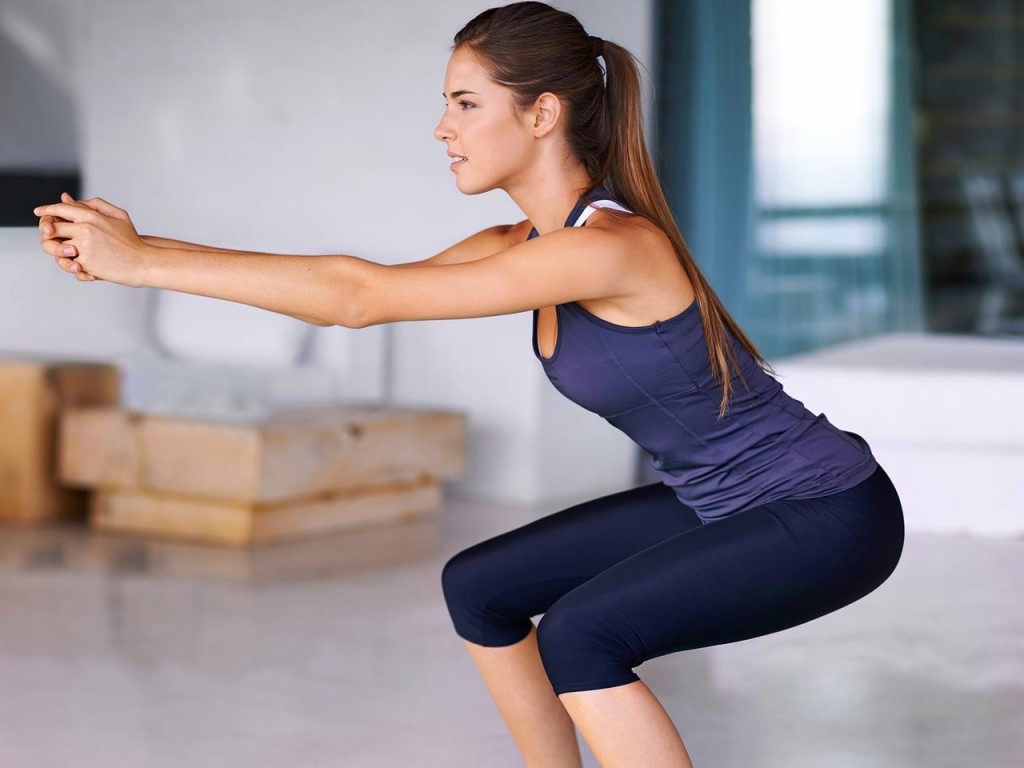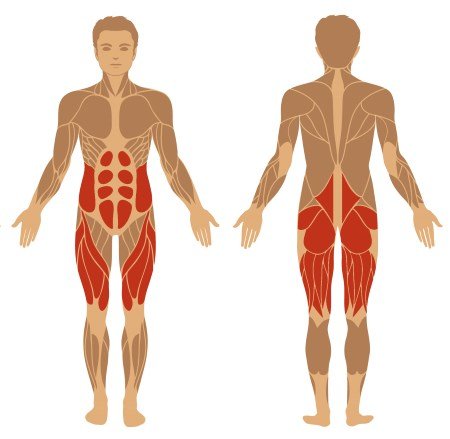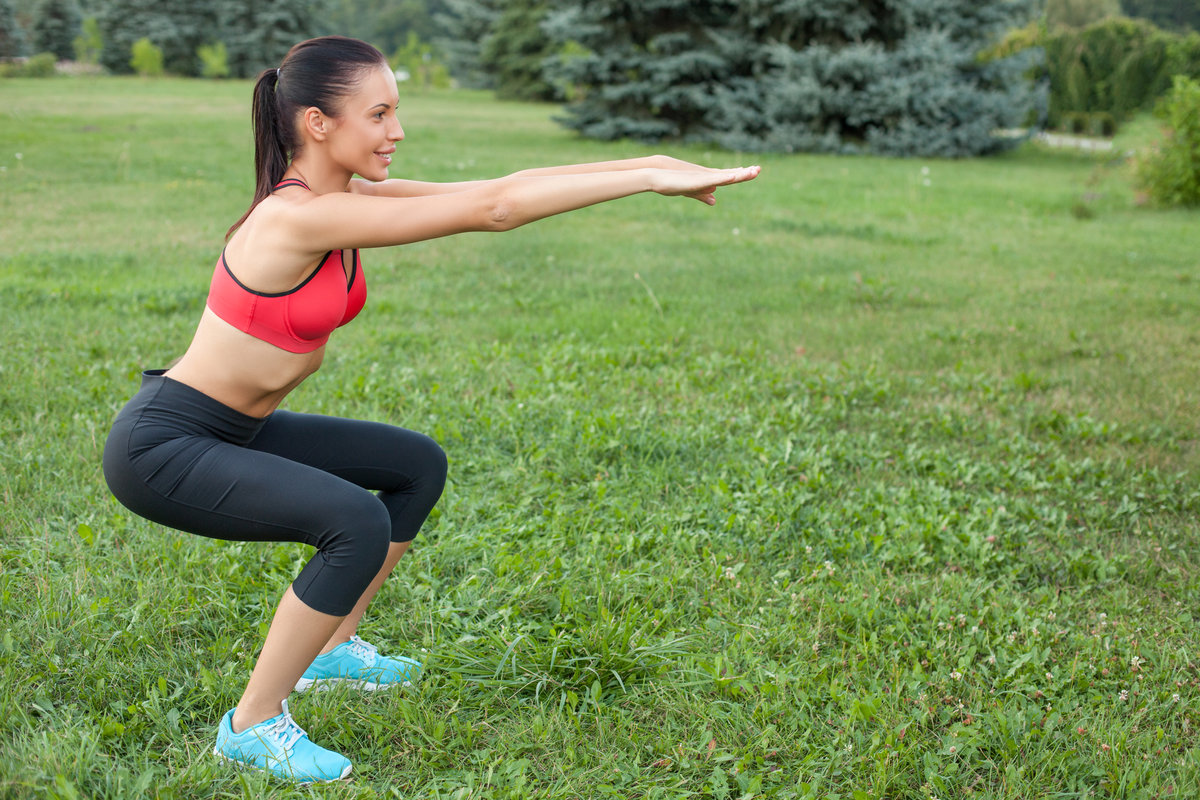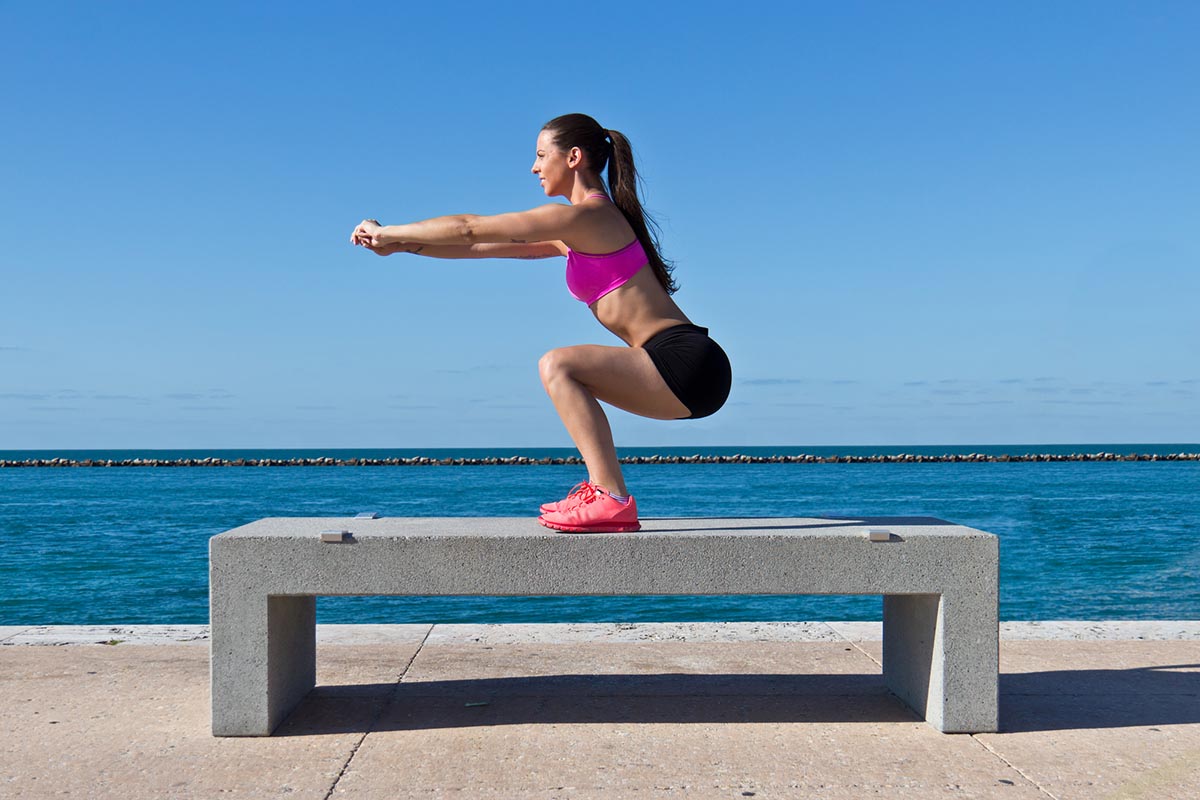If there is one exercise that should never be missing from a good leg workout, it is the squat. However, many do not find it easy to get their squats right. The effectiveness of this complex basic exercise of course stands or falls with the right squat execution.
For this reason, with this article I want to give you a few rules that you should pay attention to if you want to do your squats really well and effectively. With the squat technique you can pay attention to many small things and your shape will never be 100% perfect. However, in my opinion, there are a few things that are extremely important for a really good squat. If you keep these things in mind, your execution will quickly be much better than most of the others in your gym. So that you don’t lose yourself unnecessarily in detail and can concentrate on the really central things, I have condensed these essential rules here.
I will also cover some basics in the article that you should know. This includes, for example, why it makes sense to do squats at all, which muscles are primarily trained and what possible alternative exercises are.
I’ve broken the article into the following sections. With one click you come directly to the section that interests you most.
After reading this, you should know enough about the squat to use them in good conscience and understand their benefits. I am sure: with a little practice you will soon be able to do your squats really well.

Why you should do squats regularly
When it comes to particularly effective strength training exercises, the squat, next to the deadlift and the Bench press , almost always mentioned as one of the first disciplines. No wonder, hardly any other strength exercise brings so many benefits for your training and life.
This applies regardless of where the current focus of your training is. Whether you want to build muscle mass and do hypertrophy training , squats fit just as well into your training plan as they do for your strength endurance training . To make it clear to you why this is so, I want to briefly summarize the most important arguments why you should have squats as a central exercise in your training plan.
1) Squats performed correctly are highly functional
The squat itself is an absolutely natural movement. Doing squats correctly will therefore also be useful for your everyday movement . You strengthen your muscles in a way that is useful in a wide variety of sports and in everyday situations. This also includes the increased efficiency of your heart, which you acquire with such highly complex and strenuous exercises.
Contrary to popular belief, regular, properly performed squats take the strain off your joints and don’t put any strain on them. In addition, you will also notice an increase in your mobility after a while. This in turn is useful for various everyday movements.
2) The squat improves your balance and mobility
Only deep squats are really well executed squats. If you do your squats correctly, the range of motion is very large. This requires good mobility in your hip, knee and ankle joints. If you are not that flexible at this point, you will slowly train yourself to a very good squat form. In the course of this, your mobility increases in these joints. A positive side effect is that it often eliminates everyday complaints that you didn’t even know were due to the restricted mobility.
Many people these days do not have a particularly well-developed balance. Squats can help improve balance and overall body awareness. Due to the rather high position of the not inconsiderable weight, a balance for the body and the loaded weight must be kept under load. This is a real challenge for some beginners. But don’t worry, it will improve quickly and also have a positive effect on your stability and your body feeling in everyday life. With a squat in the multi press, of course, you don’t have this effect.
3) Squats are good for your health
There are many rumors about the harmfulness of squats. In fact, doing squats properly is very good for your health. It is not true that squats break your knees, nor that they harm other joints, cartilage, and tendons. Correctly executed squats are healthy and use all of these body structures.
Regular, heavy squats especially strengthen your bones and joints. Due to the pressure of the weight during movement, these structures are particularly stressed and compressed and stimulated to adapt. In the case of bones, this leads to an increase in bone density and thus bone stability. This in turn makes the squat a perfect way to prevent osteoporosis.
By building up muscles and exercising posture, a good squat technique also supports a healthy posture and helps to counteract common postural problems and common hip and back problems. This in turn also has a positive effect in connection with reason 4. 😉
4) Squats make you strong and sexy
There is hardly a better exercise for strong legs and a nice, round bottom than the squat. Similar to the deadlift, this exercise also requires a lot of energy consumption and the release of growth hormones due to the great strain on the muscles compared to other exercises. The result is positive effects on the metabolism and muscle growth. This is also extremely helpful if you define your muscles and want to maintain as much muscle mass as possible.
All of this means that you will achieve your target figure faster and more effectively with every goal of your strength training if you do squats regularly.
If these reasons have not convinced you to do squats regularly in your strength training, then I can no longer help you. 😉
Which muscles are trained in squats
Squats are one of the most complex basic exercises. This means that a large number of muscles are involved in the movement. The squat is probably the basic exercise with the highest total muscle activation. In other words, the total stress on all muscles is the highest. This is also due to the fact that the muscles that are primarily used are particularly large.
I’m not going to go into all of the muscles that play a role in stabilization and support during squats. The following muscles are the main target muscles in squat workouts:

Simply put, you mainly train your thighs, buttocks and core muscles with squats. If you would like to know more precisely, these are essentially the following muscles:
- Front thigh muscles (quadriceps muscles)
- Posterior thigh muscles (hamstrings, hemisphere muscles, flat tendons)
- Gluteus and hip muscles (especially gluteus maximus, medius and minimus)
- Back extensor (musculus erector spinae)
- Abdominal muscles
These are basically the essential squat muscles. In addition, some other muscles are also involved in the movement. The lower leg muscles still make a not insignificant contribution here. The upper body is not left out either, as the weight in the neck has to be kept stable. Nevertheless, I think there is no question that the squat is a central exercise in leg training because of the essential muscles. Regardless of whether you follow a split training plan or do full-body training , you should not do without this exercise.
5 rules with which you can do your squats really well
Let’s finally get to the squat execution. There are many subtleties that you can pay attention to with squats in order to do them as effectively and cleanly as possible. However, there is a risk of getting bogged down and occupying yourself for a long time with things that have little impact on your training success. However, if you want to get your squat right and get it done quickly, there are a few simple rules to focus on.
I have paid attention to this with many people and also found out from other, good coaches where mistakes are often made in the squat and what can quickly lead to a significant improvement. In the following, I would like to briefly introduce you to the five most important rules of a good squat execution. This will allow you to improve your squats really quickly and significantly.
Good squats rule 1: Find the right stance
The correct position for the squat is individual. How far apart your feet are and at what angle your feet and knees are optimally directed outwards, that is largely individual. Sure, I could now say that you should stand hip-width apart and bend your toes forward. However, I cannot say whether this is really ideal for you. To find the right level, you can simply try out what feels best for you free. Which foot position feels best, most free in the hips and knees? It is best to start straight, hip-width apart and slowly turn your feet outwards. Make sure that your knees always point towards your toes.
Squat Technique Rule 2: The trunk is trump
Similar to the deadlift, a straight back is essential for a clean and healthy execution of the squat. You should make sure to keep your core muscles permanently under tension during the entire movement. This includes the tension in your lower back but also in your abdominal muscles. Make sure that your back stays in a balanced, neutral shape.
A good tension in your abdominal / core muscles prevents typical mistakes like the butt wink (hip tilting) or a strong hollow back. Both can lead to problems in the medium to long term. To support core stability, many train with a weight lifting belt *.
Squats Rule 3: Stable knees are healthy knees
Many exercisers clearly underestimate the importance of stable knees in their squat technique. The name should already indicate that special attention should be paid here. Neither on the way up nor down should you let your knees collapse (badly). Make sure that your knees are pointing in the direction of your toes. It is better to point the knees a little further outwards than inwards. If your knees dip in, you run the risk of irritation and injury by transmitting it to your ankles and Achilles tendon. If you feel that your knees are falling in, you can consciously push your knees slightly outwards to counteract this
Squat Rule 4: Start the squat correctly
The right starting position often decides between a good and a bad squat. To do this, lay the bar at a height so that you can lift it out of the rack without going on tiptoe (around chest height). Then take the bar on your upper trapezius (large neck muscle) and grip so tightly that you can still grip the bar reasonably comfortable and push your elbows back. From this position you can start and lift the bar out of the rack. Take a step back and start bending.
Squats Rule 5: Push the hips backwards / forwards
Pay attention to what your hips are doing when you move up and down. On the way up, you push them forward from the beginning. In this way you avoid a disadvantageous two-part movement. On the way down, you push it backwards so that you can imagine you would want to sit on the toilet. You make the downward movement so deep that you can still keep your back straight. Your hips should be at least below the level of your knees.
Bonus tip: Always let someone look at your execution
This is not exactly a technique rule, but makes sense for a good development of the execution of your squats. If you have the opportunity to train with a training partner , then help each other to improve your technique.
Let your gym buddy pay attention to your execution when doing the squat. Make sure to also have him make a video of your execution and offer to do the same. You simply don’t notice some mistakes yourself. External observation or assessment using a video can help to identify errors and react to them early.
If you just pay attention to these things and use them one by one to gradually improve your squat, in a short time you will be getting your squat right (better) than 99% of the people who do most Exercise gyms.
Which rules you can safely forget
There are a few more rules about squats that you should forget once you’ve learned them. I don’t know exactly how these false rules came about, but at this point I would like to clear them up. Even if many people still claim otherwise, I want to clarify three things briefly:
- Pressed breathing is not dangerous when squatting. It is safe and sensible, as it helps you to increase your core stability.
- Deep squats aren’t unhealthy. On the contrary, you should definitely do the deepest possible squat, where you go below 90 degrees.
- It is not harmful for your knees to go over your tiptoe. Better make sure that they go towards your knees.
Here are two more videos of me doing a squat
This is what it could look like if you follow these rules. The execution is not always 100% perfect for me either, but as I said, it is especially important that you concentrate on the things that really make a difference and help you improve your technique quickly.

On the second video you can also see very well how you really recognize a so-called butt wink or why there is none here, namely because the lower back is not rounded. If the pelvis moves a little in the lowest position, that is perfectly fine and physiologically not possible otherwise for most people. It is important that the lumbar spine remains stable.
Useful squat accessories
At the latest when you have been training a little longer and also doing (heavy) squats, but probably much earlier, you will ask yourself the question of good equipment. After all, you want to get the most out of your training. You will also often see other people exercising with various equipment doing their leg training.
In the following I would like to introduce you to frequently recommended equipment that should help you to do your squats even better and harder and briefly explain whether and under what circumstances I consider their use to be useful.
Weightlifting shoes
The use of weightlifting shoes when performing squats is usually not much discussed among strength athletes, weightlifters, and powerlifters. They have some advantages rather than major disadvantages in terms of posture and exercise performance. The additional stability of the foot and the slight change in posture due to the heel wedge enable most exercisers to develop greater strength through a more stable and upright stance. Because such a shoe can also help to get deeper into the squat with limited mobility, many can (first of all) only perform the squat properly with such shoes.
I personally wear my Adidas Powerlift weightlifting shoes * for squats. The resulting improved mobility and stability helps me to do my squats correctly. I just come down really deeply, much more stable, without curving my lower back. I’ve also bent over barefoot, but I don’t find that particularly hygienic or particularly stable.
Weightlifting belt
There is hardly any other training tool that I am asked as often as training belts. A belt like this, if used correctly, will help you to maximize core stability. This provides additional security and increases performance. Very often, too weak core muscles are the weakest link in the squat.
I have a Powerlifting weightlifting belt made of full leather *, which I don’t really use at the moment. This is because I don’t particularly like to wear it and don’t consider it necessary for hypertrophy training . In this type of training, the belt only helps me to a limited extent in terms of my training performance. That’s why I don’t feel like having my belt with me all the time during my workout. At the latest in my next cycle maximum strength training (high weight, few repetitions), however, I will certainly get the belt out of the closet again. That makes me feel safer and I can develop a lot more strength. Even then, I don’t wear the belt to warm up and I think it’s important to be able to build core stability without such a belt.
Knee bandages or knee sleeves
More and more often I see athletes who do their squats with bandages or so-called knee sleeves like the neoprene knee bandages by Rehband *. Especially after a knee injury, I often see people with these kinds of neoprene gauntlets in the gym.
I honestly don’t use knee sleeves. However, I know people who swear by it when they do the heavier squats. This is because the sleeves stabilize the knees and keep them warm. Especially if you’ve already had an injury in this area, the benefits should not be underestimated.
If the knees get cold from long breaks between sets during strength training , the risk of injury increases. A couple of good knee sleeves can help. But even without a previous injury, the better blood circulation and stabilization of the knee increases the performance of the squat (a little).
Neck roll
Many people do their squats with a foam roller on the back of their necks. If you want to get your squats right, then you should stay away from it. Believe me, you are doing yourself a disservice with a thing like this. It may be more comfortable to have a metal bar on your neck, but this small advantage doesn’t outweigh the disadvantages.
With such a foam roller, your stability suffers massively. When a heavy weight rests on such a high point in your body, it is difficult enough to keep the weight stable even without foam. So keep your fingers off the neck roll if you want to do your squats correctly and minimize your risk of injury.
Which other squat variants are available
Heavy, deep squats are demanding, strenuous, and for many people not necessarily very pleasant exercise. That’s why I’m often asked about alternative exercises. Actually, I think that you should definitely master the squat and regularly make it a central part of your training.
Trying a different exercise for a change can make sense, however. It can make sense to bring a little variety and variety into your training every now and then. You can also set other priorities in your training with different variants. I can recommend the following three squat variants for this:
- Front squat: This variant enables a significantly more upright squat due to the changed center of gravity.
- Low bar squat: This variant requires a little less mobility for a deep execution. At the same time, it is possible for most people to lift more weight this way. Your hip muscles are used a little more here.
- Dumbbell squat: Variant with two dumbbells, which is particularly useful for exercising movement or if the barbell rest is not possible.
I don’t really see guided exercises such as squats on the multi-press, in the Hackenschmidt machine or the leg press as a good alternative to free squats. Nevertheless, they can be a good addition to your leg training to set specific priorities.

Your conclusion on the squat
I hope that after reading this article, you now know the benefits of regularly including squats in your training. You should also know what to look for in order to get your squats right.
If you would like to find out more about the correct execution of the squat and other basic exercises, I can warmly recommend the book Starting strenght by Marc Rippetoe *. From this book I learned a lot about the basic exercises, their uses and how to do them correctly.
If you want to go a step further, then I recommend that you do a technique check with a specialized trainer every now and then or attend a barbell workshop with one of the experts in this field. I have already attended several such seminars myself and still take a lot with me.
